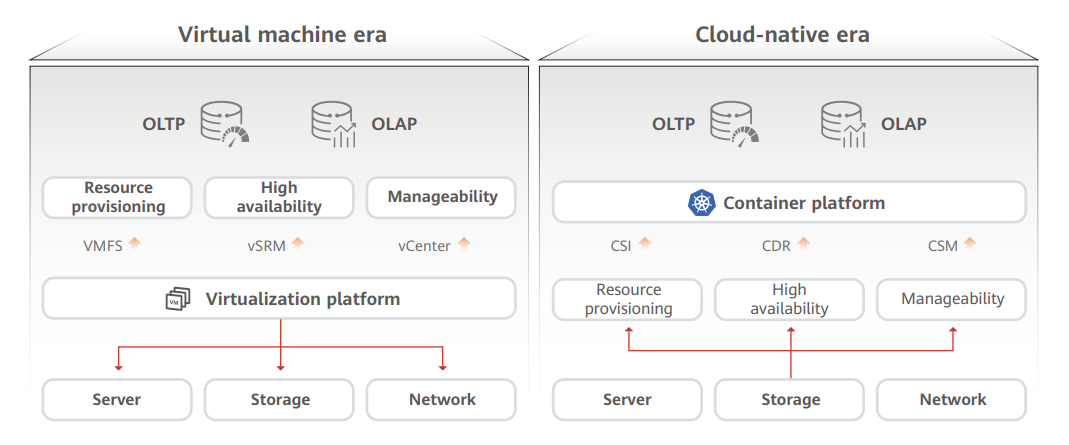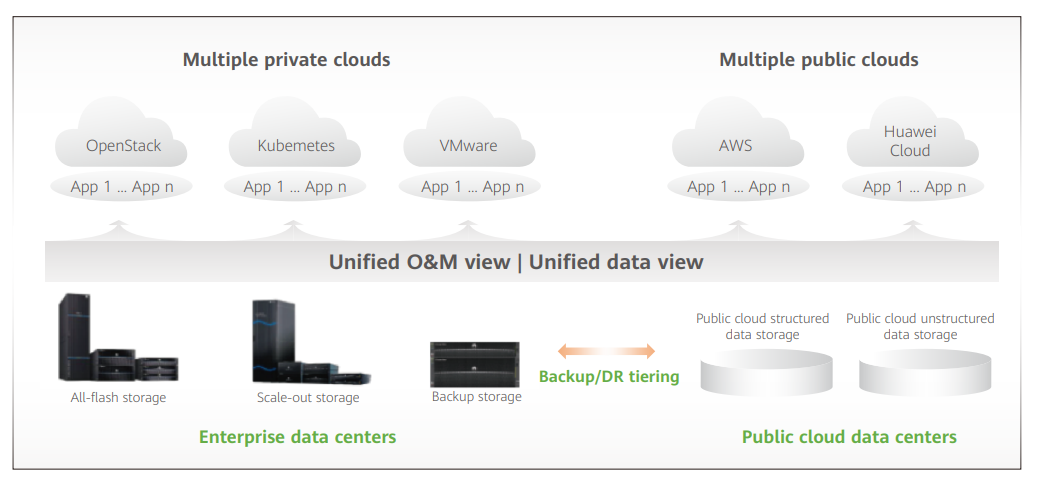Why IT Transformation Is Evolving Towards Open & Decoupled Multi-Cloud Architecture
With the vast majority of enterprises constructing multi-cloud IT architecture, cloud-native containers have become the ideal technology foundation and support infrastructures for functions such as storage, enabling enterprises to extensively construct multi-cloud architecture. And through open and decoupled architecture, cloud-native infrastructures pave the way for enterprises to integrate various optimal services and realize cross-cloud resource-sharing.
Trends
Driven by the need to accelerate innovation in applications, reduce costs, and increase efficiency, multi-cloud architecture has become the new normal for enterprise IT
Enterprise cloud computing infrastructures have shifted from a single-cloud to a multi-cloud architecture. Enterprise application and cost requirements cannot be met by any single cloud. Consequently, 89% of enterprises have turned to a multi-cloud IT architecture that incorporates both public and private clouds.
Enterprises are keeping their key stable services locally but building new services or services with uncertain traffic on clouds.
The IT infrastructure provides two key capabilities for multi-cloud architecture: cross-cloud data mobility and cross-cloud data management. For example, Huawei and NetApp storage devices support cross-cloud tiering and backup, enabling data to always use the most cost-effective storage service. Cross-cloud data management allows users to see overall data status through a global data view and schedule data to applications that generate the most value.Figure 1: Comparison between the virtual machine era and the cloud-native era

As container-based cloud-native applications are increasingly used in key services, storage support for containers will become a necessity
According to a CNCF survey, 96% of customers are building container platforms, and 95% of new applications are being deployed in containers.
As the migration of critical enterprise applications to containers is well underway, 61% of containerized applications are currently stateful applications, which require their interaction data to be stored persistently. Therefore, more highly reliable enterprise-level storage will be needed to offer support. For one thing, storage must support the configuration and extension of container storage interfaces so as to facilitate fast resource provisioning and the DR of containerized applications. For another, storage needs to collaborate with new cloud-native applications running on the containers to build the best practices.
Cloud-native infrastructures are becoming more open and decoupled
Globally, cloud infrastructure construction can be broken down into two categories:
1. full-stack closed construction
2. open and decoupled construction
As enterprises continue pursuing multi-cloud construction and increasingly demand optimal services with lower cost and higher efficiency, openness + decoupling is establishing itself as a mainstream model.
This structure makes sharing hardware resources over multiple clouds possible and enables data to flow between them freely, which is a major way of showcasing the strengths of a multi-cloud architecture.
Optimal services, from hardware and platforms to applications, are often provided by different vendors. Therefore, open and decoupled construction can help enterprises build optimal IT stacks, giving IT giants a competitive edge in terms of hardware infrastructure capabilities. No vendor can provide the optimal end-to-end AI training/inference solution on its own. So, when deploying AI training/inference clusters, enterprises often choose open and decoupled architectures so that they can select the optimal hardware as well as training/inference models.
Figure 2: Enterprise multi-cloud IT architecture

Data storage will strike a balance between CAPEX and OPEX business models
The business model of clouds is shifting from CAPEX-based to OPEX-based, which is simultaneously reshaping the business model of data storage for enterprises. Enterprises are shifting their attention away from assets, features, and functions, and placing a greater emphasis on business outcomes delivered by procurement services. As a result, SLA- and result-based OPEX business model is gaining in popularity. Furthermore, due to mounting global economic pressures, enterprises are becoming more sensitive to the cost of trial and error. This makes the OPEX business model, which offers high elasticity and low initial costs, a less risky and more preferable choice for enterprises.
However, as data storage scales and contract duration extends, subscription-based services may not always be the most cost-efficient choice for construction. A combination of CAPEX and OPEX business models may therefore be the optimal solution. However, for large-scale enterprises with stable service revenues, the CAPEX model tends to be the preferred choice.
Suggestions
1. Migrate innovative services that have uncertainties, along with emerging services like OA to public clouds, while retaining core services in their on-premises data centers
Innovative and emerging services require IT systems to deliver elastic scaling and on-demand resource application and release. Public clouds provide benefits that are less costly, more reliable, and offer good elasticity. To preserve the competitiveness of core services, enterprises must develop strong capabilities in IT platform R&D and prioritize service confidentiality. Therefore, retaining core services in enterprises' on-premises data centers can truly stimulate IT R&D and innovation, implement independent data control and operation, and prevent cloud vendor lock-in.
2. Container platform teams should collaborate with storage teams to build agile and highly reliable container platforms and develop best practices for containerized applications
Container teams should work with storage teams to build highly reliable container platforms and develop interface standards for containers and storage devices, so that storage resources and containers can be provisioned simultaneously in an agile manner. Furthermore, enterprises can gradually develop their own best practices for containerized application construction during the cloud-native transformation. Through continuous optimization, enterprises can accumulate valuable experience and knowledge that will prove invaluable in navigating the multi-cloud era.
3. Develop open and decoupled architecture for cloud construction
Thanks to its open and decoupled architecture, cloud-based IT infrastructure can optimize services, costs, and flexibility, and is becoming the mainstream choice for enterprises. It is crucial that enterprises open up procurement models to select the optimal component vendors. In addition, cloud platform vendors must open up their interfaces and take the lead in establishing interconnection standards with infrastructure providers.
4. Select the suitable business models based on enterprise and service requirements
When it comes to selecting a business model, enterprises should carefully take their business development status into consideration, and make flexible choices based on the overall benefits and risks involved.
Learn more about Huawei Data Storage and subscribe to this blog to get notifications of all the latest posts.
Disclaimer: Any views and/or opinions expressed in this post by individual authors or contributors are their personal views and/or opinions and do not necessarily reflect the views and/or opinions of Huawei Technologies.
Leave a Comment